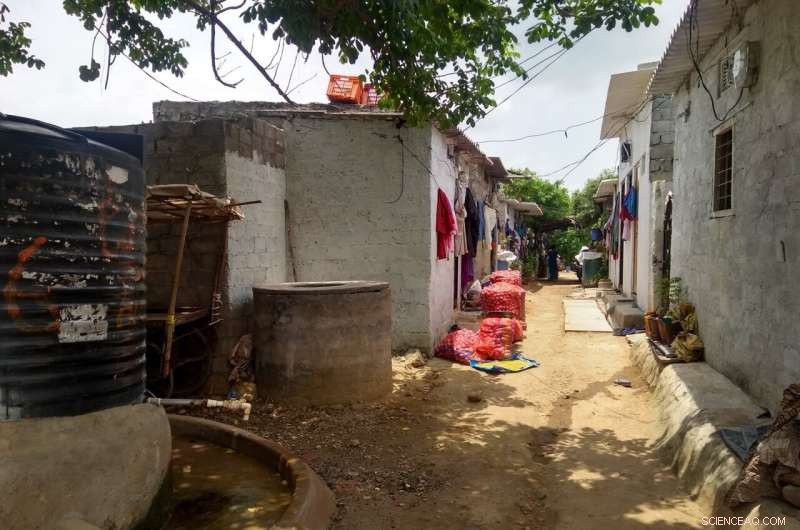
Detta foto är taget i ett stadsnära område nära Hyderabad, Indien. I förgrunden kan du se den infrastruktur som finns tillgänglig för att leverera vatten. Området är ännu inte anslutet till ledningsvattensystemet, men dessa stora vattenmen kan fyllas via regnvatten, eller med vatten som levereras till området med lastbilar. I mitten syns stora påsar med mat, som kan transporteras in i området med hjälp av fordon, boskap och för hand. I bakgrunden finns kvarvarande grönområden - en stark kontrast till de relativt täta bostäderna i mellanlandet. Kredit:Professor Simon Willcock
Världen vi lever i är ofta uppdelad med en binär skillnad mellan stad och landsbygd, trots en enorm gradient av bosättningsmönster i och runt städer – allt från urbana till de mest avlägsna landsbygdsområdena. Ny forskning leddes genom ett gemensamt forskningsprojekt Storbritannien och Indien och publicerades i Nature Sustainability , överväger urbanisering genom att titta på förändringar i naturlig, konstruerad och institutionell infrastruktur. Studien, fokuserad på det globala södern, tyder på att snabba förändringar i förortsområden (som kallas "periurbana") leder till att människor som bor i dessa områden har sämre livskvalitet än människor som bor i stads- och landsbygdsområden.
"Världens stadsbefolkning kommer att fortsätta att växa, vilket leder till en alltmer urbaniserad planet, vilket ofta resulterar i urban expansion, eftersom städer sträcker sig utåt och omfattar mark runt dem. Denna expansion av städer är särskilt snabb i utvecklingsländer i Asien och Afrika", säger professor Kenneth Lynch (University of Gloucestershire).
Professor Simon Willcock från Bangor University och Rothamsted Research säger:"När stadsområdena expanderar förändras egenskaperna och tjänsterna inom områdena. Till exempel är natur och naturprodukter ofta mer omedelbart tillgängliga på landsbygden, med lägre nivåer i stadsområden, medan byggd infrastruktur visar det motsatta mönstret. Detta åtföljs ibland också av ett skifte från lokalt, traditionellt ledarskap på landsbygden till mer central styrning i städerna."
Forskningen presenterar en ny teori om peri-urban turbulens, som Dr. Paul Hutchings från Leeds University förklarar:"Naturens hastighet är skadad och kostnaden för att bygga ny infrastruktur är viktiga drivkrafter för att bestämma livskvaliteten för människor som bor i peri. När till exempel utvinning av produkter från naturen har en hög miljökostnad, kan naturen bara försörja ett fåtal människor. På samma sätt, när kostnaderna för att bygga infrastruktur också är höga, är det bara ekonomiskt lönsamt att stödja större samhällen. I en situation som denna kommer resurser som kommer från den naturliga världen sannolikt att försvinna innan de kan ersättas av byggd infrastruktur."
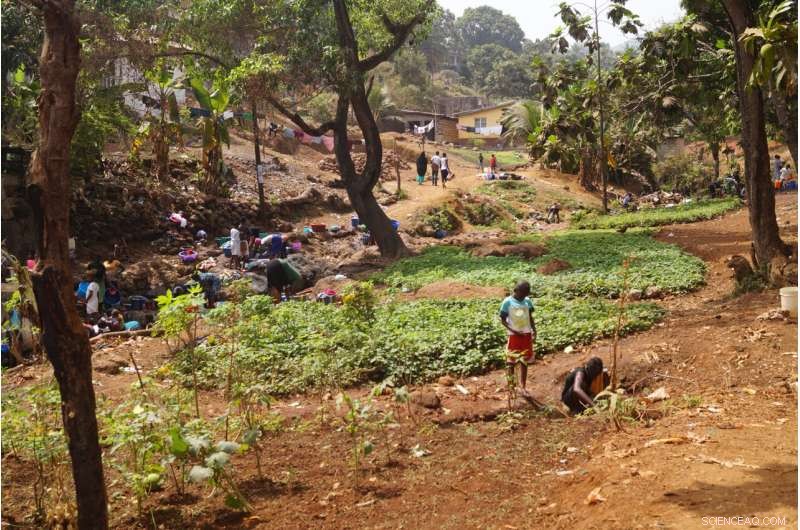
Detta foto är taget mellan två stadsdelar som tittar upp en bäck nära Freetown, Sierra Leone. I förgrunden kan du se två barn som utvinner vatten ur en brunn för att vattna små grönsaksträdgårdar bakom dem. In the middle ground, a group of women and children are washing clothes and themselves in the stream and up the slope and behind the banana trees, the residential dwellings, some of which are in construction. You can also observe, rubbish littering the catchment, building materials in the form of boulders, some of which have been arranged to reduce erosion and landslip and dotted about some mature trees, some of which show evidence of having branches removed for fuelwood. Credit:Professor Kenneth Lynch
"Previous evidence supports this. For example, child health in East Africa is lowest in those communities living between the city and countryside, whilst a study in South Africa found that around two thirds of urban and rural citizens report that their quality of life had improved over the last five years, but only half of respondents reported such improvement in peri-urban zones," says Professor Kenneth Lynch.
Professor Simon Willcock explains the limitations of the theory:"This type of negative experience in peri-urban areas is greater for some services than others, and varies across geographic areas. For example, most food is grown in rural areas, but this can also be done within cities. Food can also be transported by road within cities with relative ease. However, there are likely to be big differences between groups living in each context. For example, higher income households and communities living in peri-urban areas have better access to the scarce resources. They can buy-in their own water, electricity, sanitation and so forth."
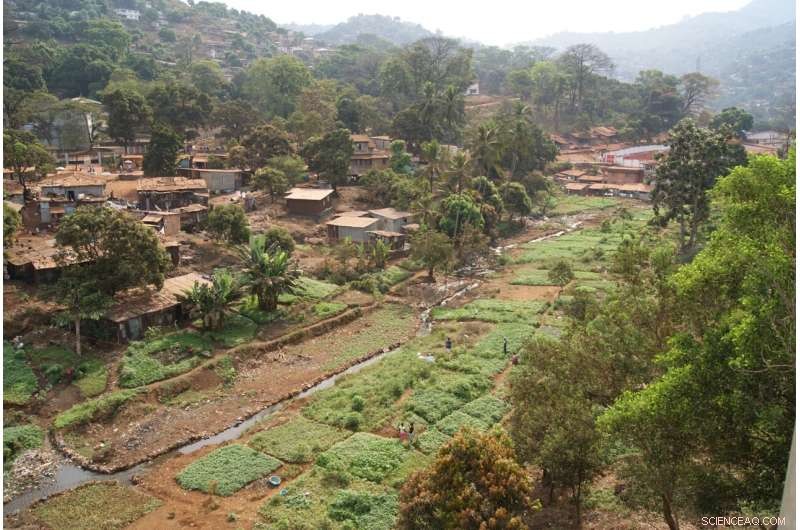
A site that floods during the rainy season that has thus far prevented development, allowing local people to use it for small-scale vegetable gardens near Freetown, Sierra Leone. Since this photo was taken two large developments have encroached on this site displacing the cultivators reducing the cultivated land cover and restricting the drainage channel, exacerbating flood water during the rainy season. Non-biodegradable waste (such as plastic bags and bottles) is used by cultivators to form drainage channels and protect plots from erosion. Credit:Professor Kenneth Lynch
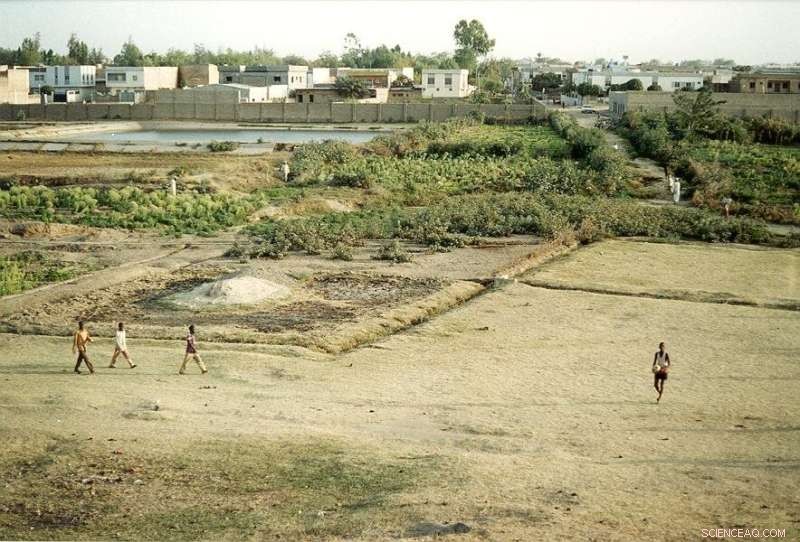
A seasonally flooded site within the old walls of the city of Kano, Northern Nigeria. You can see sites in the foreground are being used for small scale agriculture, but also plots have been marked out for construction and some sand and cement has been deposited ready for the installation of boundary markers. In the background you can see the high value residential areas that have a wall separating their neighborhood from the agricultural site. Many of the cultivators grow rice in the rainy seasons indicating this is for household consumption. During the dry season the cultivable land reduces to very close to the stream which is heavily polluted by nearby clothes dying works and the residential area. Encroachment on this site for residential development will exacerbate flooding further down the watershed. Credit:Professor Kenneth Lynch
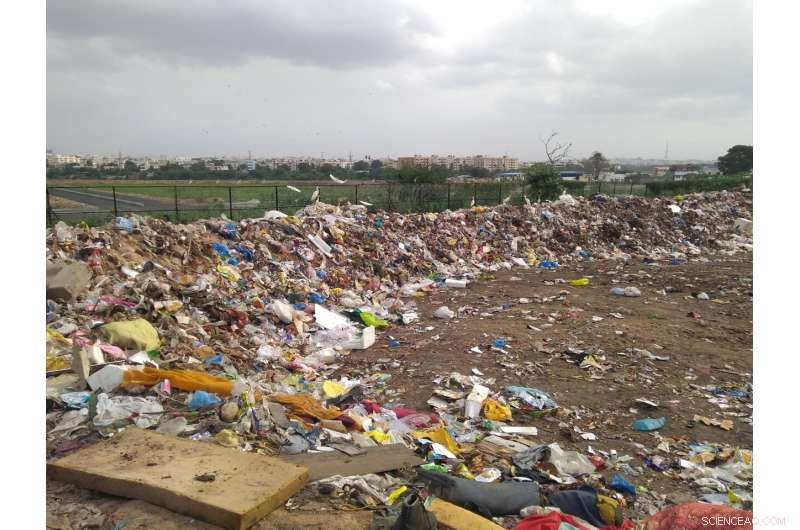
This photo is taken in a peri-urban area near Hyderabad, India. In the foreground, you can see a waste disposal area, receiving waste from the surrounding peri-urban areas, but also from the main city (shown in the background). This waste may present a hazard to the health of those living nearby, and risks polluting the nearby natural areas (shown in the middle ground). Credit:Professor Simon Willcock
Dr. Paul Hutchings concludes, "The bumpy road between natural and built infrastructure can be avoided. Some natural infrastructure can be conserved throughout urbanization through good city planning enforcing protection of green space. As well as this, services, such as municipal water utilities, can be subsidized so that they can be provided to people in peri-urban areas. Urban and rural planners, designers and architects should be working together to pre-empt the needs within newly expanded areas, and act quickly to prevent lower quality of life of the people living there." + Utforska vidare